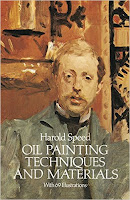 Today we'll take a look at Chapter 8: "Colour: Practical" from Harold Speed's 1924 art instruction book Oil Painting Techniques and Materials
Today we'll take a look at Chapter 8: "Colour: Practical" from Harold Speed's 1924 art instruction book Oil Painting Techniques and MaterialsI'll present Speed's main points in boldface type either verbatim or paraphrased, followed by comments of my own. If you want to add a comment, please use the numbered points to refer to the relevant section of the chapter.
We're continuing with the second half of this chapter, which starts on page 125.
1. Harold Speed's Color Chart
In my copy of the book, he doesn't show a visual of the chart he's describing, and I can't show you either because I haven't made one yet. If one of you has made one, please link me to it, and maybe I can use yours as an illustration.
Basically, you take a 20 x 24 inch white canvas and divide it into a grid of twenty-four 4-inch squares, five across the top and six squares down. The chart is to experiment with different qualities of oil colors when applied in different ways. As Loomis said, "you will have a diagram that should help you to realise the different qualities that can be got out of the same colours differently put on canvas."
The top line across is painted in red, second line purple, third line blue, fourth line green, fifth line yellow, and the sixth line is orange.
I won't further reiterate his instructions, but one piece of it that jumped out was the idea of putting a strong colored edge around an area of color. This was an old trick used by mapmakers, who would use four different colors to distinguish different counties or states, and then surround the outer edge of each area with that same color in a higher-chroma form.
Andrew Loomis, in his book, Creative Illustration , illustrates the same rule that Speed is talking about — the idea that you can boost the impression of color by intensifying the chroma at the shadow edge. "Adding a coloured edge to a mass," Speed says, "while not disturbing its purity of tone, does add colour vitality that is always apt to be lacking without it." Speed later points out that the edge where the subject meets the background is also important.
, illustrates the same rule that Speed is talking about — the idea that you can boost the impression of color by intensifying the chroma at the shadow edge. "Adding a coloured edge to a mass," Speed says, "while not disturbing its purity of tone, does add colour vitality that is always apt to be lacking without it." Speed later points out that the edge where the subject meets the background is also important.
Here are some other points that jumped out at me:
2. The difficulty with oil paint is avoiding dullness or muddiness.
You have to work to get variation of value, chroma, and hue.
3. "Colours seem to dry very dull and lifeless when painted on a ground of similar colour."
It's often a good idea to tone the board or prepare the surface with a color that is complementary to the overall color of the finished painting.
4. "It is a good thing when a part has to be repainted, to rub a thin film of white over it."
And it also helps to rub out (if possible) an area that needs to be repainted.
5. Look for the main color accent when planning a color scheme.
Build all the other colors around it to support it. "Make sure your purest notes are clean."
6. "The fewer strokes of the brush you do your work with, the fresher the painting."
If you have a habitual way of repetitively stroking the painting: 'dink....dink....dink....dink...' or 'smoosh...smoosh...smoosh...' your work might be suffering from this lack of vitality. You might want to try painting a picture with 100 touches of the brush. Or practice calligraphy, where orchestration of strokes is the name of the game. Attracting the attention of your viewer to your strokes is not the purpose of this, though. It's more to give the form more force and vitality, to convey the larger story or emotion of the piece.
7. "Look for colour in your shadows."
Don't just peer fixedly into one part of the shadow, he says, but rather look at how the shadow relates to the overall.
 |
| Joseph Paul Pettit (source) |
8. "Don't bother about the greys, the greys will come."
The grays of your painting are a natural outcome of blending and mixing and merging the brighter colors of the design. The "Pettit" he refers to is Joseph Paul Pettit (1812-1882), a British landscape painter.
9. "The feeling of colour will have no opportunity of development during your form and tone studies."
Speed puts color study in a different category from the exacting sort of work in form and tone. Although I believe there is a practical science to color, and that it's not all subjectivity, I believe it does require a different mindset than the foundation of tone and form. That mindset seems to me more emotional and intuitive and not always justifiable to reason.
 Next week—Chapter 9, "Painting from the Life"
Next week—Chapter 9, "Painting from the Life"
-----
In its original edition, the book is called "The Science and Practice of Oil Painting ." Unfortunately it's not available in a free edition, but there's an inexpensive print edition that Dover publishes under a different title "Oil Painting Techniques and Materials
." Unfortunately it's not available in a free edition, but there's an inexpensive print edition that Dover publishes under a different title "Oil Painting Techniques and Materials (with a Sargent cover)," and there's also a Kindle edition.
(with a Sargent cover)," and there's also a Kindle edition.
Get my book "Color and Light" signed from my website or from Amazon .
.
I also recommend Creative Illustration by Andrew Loomis.
by Andrew Loomis.
----Get my book "Color and Light" signed from my website or from Amazon
I also recommend Creative Illustration
GurneyJourney YouTube channel
My Public Facebook page
GurneyJourney on Pinterest
JamesGurney Art on Instagram
@GurneyJourney on Twitter









10 comments:
Thanks James!......interesting bit about the chromatic edge. Looking forward to playing with that in my own work.
I had some confusion trying to do the exercise here, so I second James and would be glad if someone could share any eventual example.
Apart from that, I've also been quite bugged by the mediums used by speed.
What is that Copal Oil, exactly? Would the modern liquin be a good enough replacement for it? If I am not mistaken, it's some kind of fast drying agent, correct?
Could liquin be equally used as thinner, instead of the linseed + turpentine mix?
Lastly, what about painting stages and color brightness? Say, I can't for any reason complete a painting in one go. I scrub the main local color over the whole object, as vivid as I can, and then, after drying, I cover it all again. Will it suffer the same-color-dullness in this case? Even if, say, I had painted the surface with its complementary, prior to this.
I don't fully understand the concept of painting a border of bright color around a color near the shadow. Is this painting what you see in front of you and this is something to look out for when looking at actual objects and shadow edges in front of you, or is this something that is not visible in nature but is a convention to make up and put into paintings to make the color effect of a picture more interesting?
James, I've heard a portrait painter say that the edge between light and shadow is grey, or the color of the background. Do you think the chroma along the shadow line shifts from high to low and if so have you noticed any consistent principles to this?
Love this series, thanks!
8. "Don't bother about the greys, the greys will come."
Not too sure about this one. One of the most common and striking "mistakes" I see today is garish and overly saturated colors. I think many contemporary painters would be well served to study masters like Thayer and Mancini, who, very evidently, bothered a great deal about grays.
Colin Boyer-This effect works better for the hard transition between two objects, or between the a foreground object and the background field. It isn't really useful for a gradual transition from light to dark such as on a round object. This effect will help define *specific* boundaries rather than a slow gradation from light to dark. For example on a portrait it would work better at the boundary between the light surface of a person's cheek and dark background. It would NOT be as useful for the transition from the light side of the face through the core shadow to the dark side of the face.
In regards the high chroma edge I observe this mostly in cast shadows in sunlight. It is especially noticeable on asphalt streets and concrete sidewalks. I first learned about this from John Barry Raybould who cautioned to "use this effect sparingly, otherwise it becomes a cliche".
For those of you that need a more scientific explanation of what is happening here, look up the key phrase: Center/Surround Organization of the Visual Field. This effect described by Harold Speed and Andrew Loomis is a sort of optical illusion. It’s a trick of the eye that is based upon how visual information is processes by the cells in your eye as well as the visual centers of the brain. Visual information is hierarchical, with more importance give to specific boundaries between objects rather than gradual changes of value or color. It takes a lot of caloric energy for the brain to process so much information, so we have evolved certain shorthands for processing so much visual information. One of these shorthands is that the various cells of the eye tend to group individual signals from your rods and cones together and compare them against each other as well as against other groupings of cells, with the primary purpose of identifying the boundaries between objects (The center/surround organization). Your eye will spend a lot of energy identifying the value and color differences between an object’s boundary, and very little energy with the rest of the object. A good analogy is how a JPEG digital image is coded. If you have a yellow square on a brown background, a JPEG codes the boundaries of the square and the specific colors at the boundaries. It then codes that everything on the interior of the square is the same color as that at the boundary. Our brains do a similar thing. They look at the edges of objects and process the color differences at the boundaries and then “fill-in” the rest with our imagination rather than actually spending the energy to process the whole field. So the use of this optical illusion is best used between the *outer* contours of an object rather than the interior gradual changes color or value *within* the form.
I'm sure there are many examples of chromatic edges, but I always remember a painting by Susan Lyon that seemed to exemplify it perfectly. This is crop, but illustrates it well : http://www.susanlyon.com/Susans_archive/2013%20Susan/goldenshawl-susanlyon-40by30-oilcu.jpg
Thanks James. Chromatic edges- who woulda thunk...now that it's been pointed out I'm seeing it everywhere.
Post a Comment